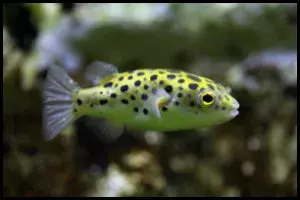
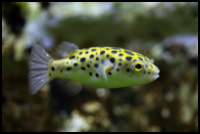
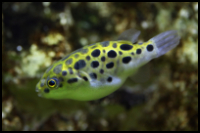
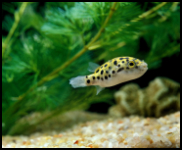
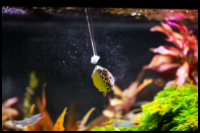
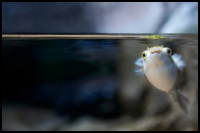
Quick Care Details (Table)
| Livestock Characteristics | Value |
|---|---|
| Care Level | Moderate |
| Temperament | Aggressive |
| Diet | Carnivore |
| Maximum Size | 6 Inches |
| Minimum Tank Size | 30 Gallons |
| Plant Safe | Yes |
| Temperature Range | 72-78F |
| PH Range | 7.5-8.0 |
| Salinity | 1.005-1.025 |
Species Specific Categories
Helpful Video
Care Details
Aquascape: Creating a puffer-friendly aquascape involves balancing open swimming space with plenty of hiding spots. Use live or artificial plants like java ferns, anubias, or hornwort, along with caves or PVC pipe fittings to mimic their natural environment.
Substrate: A soft sand substrate is ideal, as it mimics the riverbeds of their native habitat and prevents injuries to their delicate underbellies.
Disease Prevention: Maintaining pristine water quality is crucial. Regular water changes, proper filtration, and monitoring ammonia, nitrites, and nitrates help prevent diseases.
Filtration: Invest in efficient filtration since puffers are messy eaters. A canister or sponge filter works well without creating too much water flow.
Lighting: Moderate lighting is sufficient, but puffers aren't picky about it. Real or artificial plants can thrive under basic aquarium lighting.
Water Flow: These fish prefer slow water flow. Position the filter outlets and decor to create gentle circulation, as strong currents stress them.
Hardiness: Green Spotted Puffers are hardy fish when kept in suitable conditions. They can adapt to a variety of water parameters, but stability is key.
Acclimation: Slow and careful acclimation is vital to prevent stress. Drip acclimation over an hour is recommended when introducing them to a new tank.
Expected Lifespan: With proper care, Green Spotted Puffers can live for 6-10 years, or even longer.
Special Requirements: Puffers have unique dietary needs. Their diet should include a mix of snails, shrimp, and occasional plant matter. The constant growth of their beaks necessitates regular access to hard-shelled prey for wear. Moreover, they are territorial, so consider their compatibility with tankmates.
Temperament and Behavior
Behavior: Green Spotted Puffers are known for their curious and intelligent behavior. They are active swimmers and constantly on the hunt for snails, crustaceans, and other food. These fish have individual personalities, and many puffer keepers find them quite charming due to their inquisitive nature.
Breeding: Breeding Green Spotted Puffers in captivity can be challenging, and it's not common in home aquariums. They are egg layers, and setting up a separate breeding tank is necessary. The process often requires mimicking their natural habitat and a specific diet to induce spawning.
Aggression: These puffers are territorial and can be aggressive, especially towards their own kind. They may also nip at the fins of slower-moving tankmates. It's crucial to provide hiding places to reduce aggression.
Tankmates Compatibility: Selecting suitable tankmates can be tricky due to their territorial and sometimes aggressive nature. Peaceful but robust fish or species that occupy different tank regions can work. Be cautious with slow-swimming or long-finned fish.
Activity Level: Green Spotted Puffers are highly active and spend a lot of time exploring their environment, hunting, and interacting with their surroundings.
Schooling or Shoaling Behavior: They are not schooling fish and are generally solitary, as they tend to show aggression towards conspecifics.
Plant Compatibility: These puffers are notorious plant-nibblers and may devour or uproot live aquatic plants. Artificial plants might be a better choice for maintaining your tank's aesthetics.
Coral Reef Compatibility: Green Spotted Puffers are not suitable for reef tanks due to their snail and invertebrate-based diet. They may harm or eat corals and other invertebrates, so it's best to avoid them in reef setups.
Diet and Nutrition
Dry Foods: Green Spotted Puffers can accept some dry foods, such as high-quality pellets or flakes just like the pea puffers. However, they have beaks designed for crushing shells, so these should be supplemented with a more natural diet to keep their beak healthy.
Frozen Foods: These puffers eagerly devour a variety of frozen foods, including bloodworms, brine shrimp, and daphnia. These options are closer to their natural diet and are highly nutritious.
Live Foods: Their primary food source should include live foods like snails, crustaceans, and small fish. Feeding them live prey is not only enjoyable for the puffer but also helps maintain their beak's length and health.
Vegetables: While not a staple, you can occasionally offer small bits of blanched vegetables like peas or zucchini. This adds some variety to their diet.
Algae: Green Spotted Puffers do eat some algae but should not rely solely on it for their diet. Providing a well-rounded diet is essential for their health.
Feeding Schedule: Green Spotted Puffers are voracious eaters, and it's crucial not to overfeed them. Offer a variety of foods in small portions multiple times a day. This mimics their natural foraging behavior and helps prevent obesity.
Supplemental Foods: To ensure their nutritional needs are met, consider using calcium supplements, which can help maintain their beak's health.
Tank Parameters
Tank Size: Green Spotted Puffers require a tank size of at least 30 gallons for a single puffer. Larger tanks, such as 55 gallons or more, are even better as they offer more space for swimming and exploring.
Tank Length and Measurements: A 30-gallon tank typically measures about 36 inches in length, 12 inches in width, and 16 inches in height. Larger tanks should follow appropriate dimensions to accommodate their needs.
Species Maximum Size: These puffers can grow to be around 4 to 6 inches in length when fully mature. Providing adequate space in the tank ensures their growth and well-being.
Water Temperature: Maintain the water temperature between 75-82°F (24-28°C). Keep it consistent to avoid stressing the puffers.
pH (Acidity/Alkalinity): Aim for a slightly alkaline pH level around 7.0 to 8.5. This range helps support their overall health.
Nitrate (NO3) Levels: Keep nitrate levels low, ideally below 20 ppm (parts per million). Regular water changes can help with this.
Salinity: Green Spotted Puffers are often found in brackish water in the wild. Maintaining a salinity level of around 1.005-1.008 specific gravity is recommended. Adjust it as they grow, and monitor closely during water changes.
Phosphate (PO4): Phosphate levels should be low, ideally below 0.3 ppm. Excess phosphate can contribute to algae growth.
Alkalinity (dKH): Aim for an alkalinity level around 5-15 dKH (degrees of carbonate hardness), which helps stabilize the pH.
History, Popularity, History and Species Variety Details
History: The Green Spotted Puffer, scientifically known as Tetraodon nigroviridis, is a captivating and popular freshwater pufferfish species. Native to Southeast Asia, particularly found in the river systems of Thailand, Malaysia, and Indonesia, it has gained popularity in the aquarium hobby due to its unique appearance and entertaining behaviors.
Popularity: This pufferfish is widely favored among aquarists, not only for its striking green coloration and distinctive spots but also for its lively and curious nature. Its ability to puff up when threatened adds to its charm. These traits have made it a sought-after choice for both novice and experienced aquarium keepers.
Natural Habitat: In the wild, Green Spotted Puffers inhabit slow-moving freshwater environments such as rivers, streams, and flooded forests. They are known to thrive in waters with dense aquatic vegetation, which provides hiding spots and adds to their natural beauty. However, due to over-collection for the aquarium trade and habitat loss, some populations of this species are at risk in the wild.
In aquariums, providing a suitable environment that mimics their natural habitat with plenty of plants, caves, and open swimming space is key to keeping these unique and engaging fish healthy and happy.
Similar fish to the Green Spot Puffer
- Avocado Puffer: These puffers have a vibrant green coloration and are often referred to as Avocado Puffers due to their resemblance to the fruit.
- Mbu Puffer: Mbu Puffers are a larger variant of the Green Spotted Puffer, known for their impressive size and distinct coloration.
- Redeye Puffer: These puffers have a unique red-orange coloration around their eyes, adding a striking feature to their appearance.
- Hairy Puffer: Hairy Puffers are identified by their fine, hair-like appendages that resemble a beard, giving them their name.
- Dwarf Freshwater Puffer: Although not a true Green Spotted Puffer, these small puffers share similar care requirements and are popular in the aquarium hobby.
Frequently Asked Questions
What's the ideal tank size for Green Spotted Puffers?
These active swimmers require at least a 30-gallon tank, but the bigger, the better. They appreciate space to roam and explore.
Can I keep Green Spotted Puffers in a community tank?
Not really. They can be nippy and aggressive, especially during feeding. It's best to keep them with their own kind or similar-sized tankmates.
What's their preferred diet?
They have strong beaks for cracking shells. Offer a diet of snails, crustaceans, and occasionally, high-quality frozen or live foods.
Can they adapt to different water conditions?
Green Spotted Puffers prefer slightly brackish water but can adapt to various conditions. Keep a close eye on water quality and maintain stable parameters.
Are Green Spotted Puffers brackish or freshwater fish?
They are known to thrive in brackish conditions, but they can be acclimated to freshwater if necessary.
Are Green Spotted Puffers easy to care for?
They require some experience due to their specialized diet and potential aggression. Novice aquarists might want to start with easier species.
How big do they get?
These puffers can grow to be around 6 inches in length, so be prepared for their eventual size.
Do Green Spotted Puffers need plants in their tank?
They are known to be plant nibblers, so if you want to keep live plants, choose hardy, robust varieties.
Are they suitable for beginners?
Not typically. These puffers are best for intermediate to advanced aquarists who can provide the specialized care they need.
Can Green Spotted Puffers recognize their owners?
While not exactly like a dog, they can become accustomed to their owners and might recognize you during feeding times.

